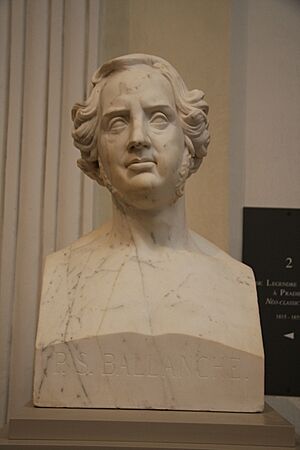Pierre-Simon Ballanche facts for kids
Pierre-Simon Ballanche (born August 4, 1776 – died June 12, 1847) was a French writer and philosopher. He had ideas about how society could improve over time, often linking these ideas to religious beliefs. Ballanche was quite important in French writing groups during the early 1800s. In 1842, he became a member of the famous Académie française, a top French council for arts and literature.
Life and Career
Early Years
Pierre-Simon Ballanche was born in Lyon, France. When he was 17, he was deeply affected by the terrible events of the French Revolution. In 1793, his city had a revolt against the government. About 700 people were killed during this time.
These experiences, along with an unhappy love affair, made him believe that life often involved suffering. He thought this suffering could be meaningful. He put these ideas into his writings. His most famous work was an unfinished series called Essais de palingénésie sociale, which means "Essays on Social Rebirth."
Ballanche used the word "palingenesis" to describe how society could be reborn or renewed over time. He believed that Christianity could lead to progress, even though he also thought its core ideas never changed.
His Career
Ballanche first worked as a printer. His first book, Du sentiment (1802), was similar to a popular book by another French writer, Chateaubriand. In 1812, he met a well-known socialite named Julie Récamier. Soon after, he moved to Paris and often visited her famous literary gatherings.
In his books like Antigone (1814) and Essays on Social Institutions (1818), Ballanche explored the idea that the French Revolution had a special, even divine, meaning. Many thinkers at the time who opposed the revolution shared this view. However, Ballanche also developed a unique idea about language.
He believed that naming something was like taking part in its creation. For Ballanche, this creative power of speech was similar to poetry. His ideas about symbols and poetry influenced the rise of romanticism, a new way of thinking about poets and art.
Ballanche's main life work was a huge, unfinished project known as Palingénésie. He started planning this "great work" in the 1820s. In 1827, he published Prolégomènes, the first part, where he shared his goal to write "the true history of the human race."
The first main volume, Orphée (1829), was about ancient Greece. He also planned a second volume about the Roman Republic, but it was never finished. Ballanche kept changing his plans for the work, making its history very complex. This was partly because he found the task very difficult. Also, the changing events in French history during the 1800s gave him new ideas all the time.
His Philosophy
Ballanche had a very original way of thinking. He believed in "progress through challenges." In a way, his ideas were like a modern version of the religious concepts of "Fall" and "Redemption." He thought that society could improve by going through difficult times.
For example, Ballanche believed that a ruler, like King Louis XVI of France, might have been meant to fall, even if he wasn't a bad person. Ballanche's view of history suggested that past times could be right and fair for their era. However, they might still lose the right to continue as society progressed.
Ballanche often compared himself to Janus, a two-faced god from mythology. This is because he looked in two directions at once. He accepted that history involved change, but he also believed that the way these changes happened often led to a need for future apologies or atonement.
Legacy
Ballanche's ideas were unique, placing him between groups that wanted progress and those who wanted to return to older traditions. He hoped to bring these different sides together. However, this didn't happen.
People on the political left found his idea that social order was supernatural hard to accept. And those on the right didn't like his willingness to accept big changes. Because of this, Ballanche remains a figure who is hard to place in one clear category.
See also
 In Spanish: Pierre-Simon Ballanche para niños
In Spanish: Pierre-Simon Ballanche para niños


